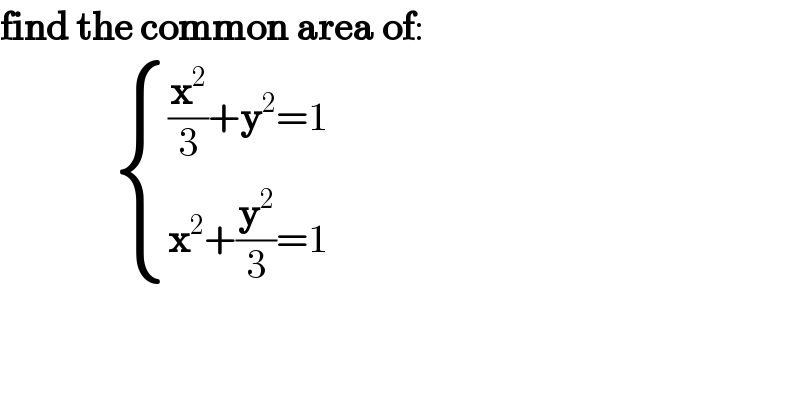
Question and Answers Forum
Question Number 57821 by behi83417@gmail.com last updated on 12/Apr/19

Answered by MJS last updated on 13/Apr/19

Answered by mr W last updated on 13/Apr/19
![r^2 =((a^2 b^2 )/(b^2 cos^2 θ+a^2 sin^2 θ)) A_(common) =8∫_0 ^(π/4) ((r^2 dθ)/2)=4a^2 b^2 ∫_0 ^(π/4) (dθ/(b^2 cos^2 θ+a^2 sin^2 θ)) =4ab[tan^(−1) ((a/b)tan θ)]_0 ^(π/4) =4ab tan^(−1) ((a/b)) with a=1, b=(√3) A_(common) =4(√3) tan^(−1) ((1/(√3)))=((4(√3)π)/6)=((2(√3)π)/3)](Q57829.png)
Commented by behi83417@gmail.com last updated on 13/Apr/19

| ||
Question and Answers Forum | ||
Question Number 57821 by behi83417@gmail.com last updated on 12/Apr/19 | ||
 | ||
Answered by MJS last updated on 13/Apr/19 | ||
 | ||
| ||
Answered by mr W last updated on 13/Apr/19 | ||
![r^2 =((a^2 b^2 )/(b^2 cos^2 θ+a^2 sin^2 θ)) A_(common) =8∫_0 ^(π/4) ((r^2 dθ)/2)=4a^2 b^2 ∫_0 ^(π/4) (dθ/(b^2 cos^2 θ+a^2 sin^2 θ)) =4ab[tan^(−1) ((a/b)tan θ)]_0 ^(π/4) =4ab tan^(−1) ((a/b)) with a=1, b=(√3) A_(common) =4(√3) tan^(−1) ((1/(√3)))=((4(√3)π)/6)=((2(√3)π)/3)](Q57829.png) | ||
| ||
Commented by behi83417@gmail.com last updated on 13/Apr/19 | ||
 | ||